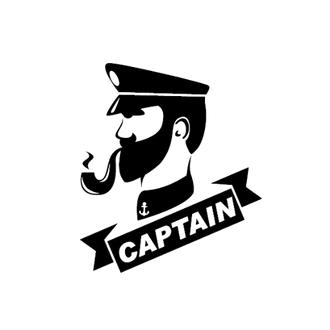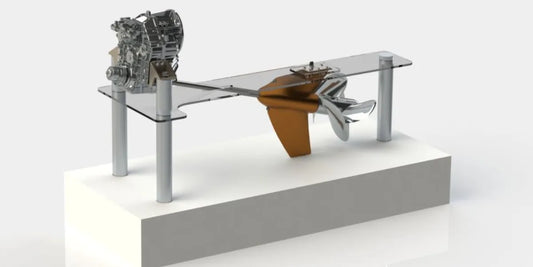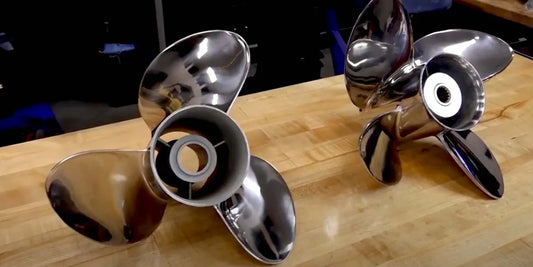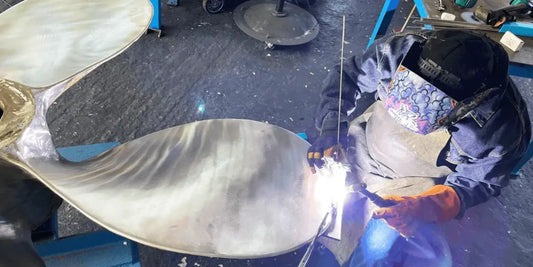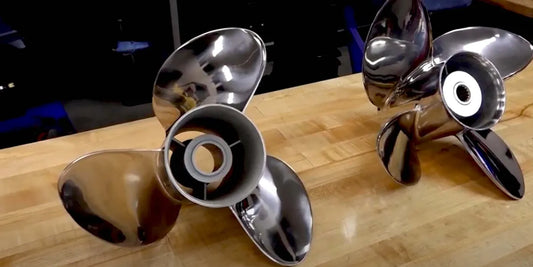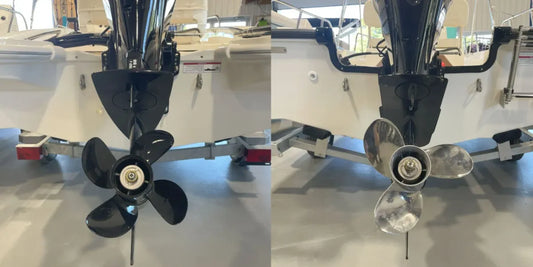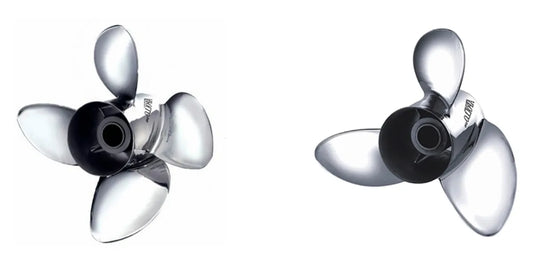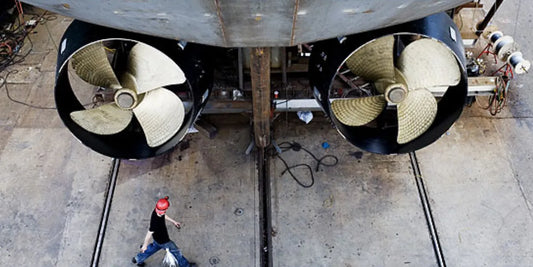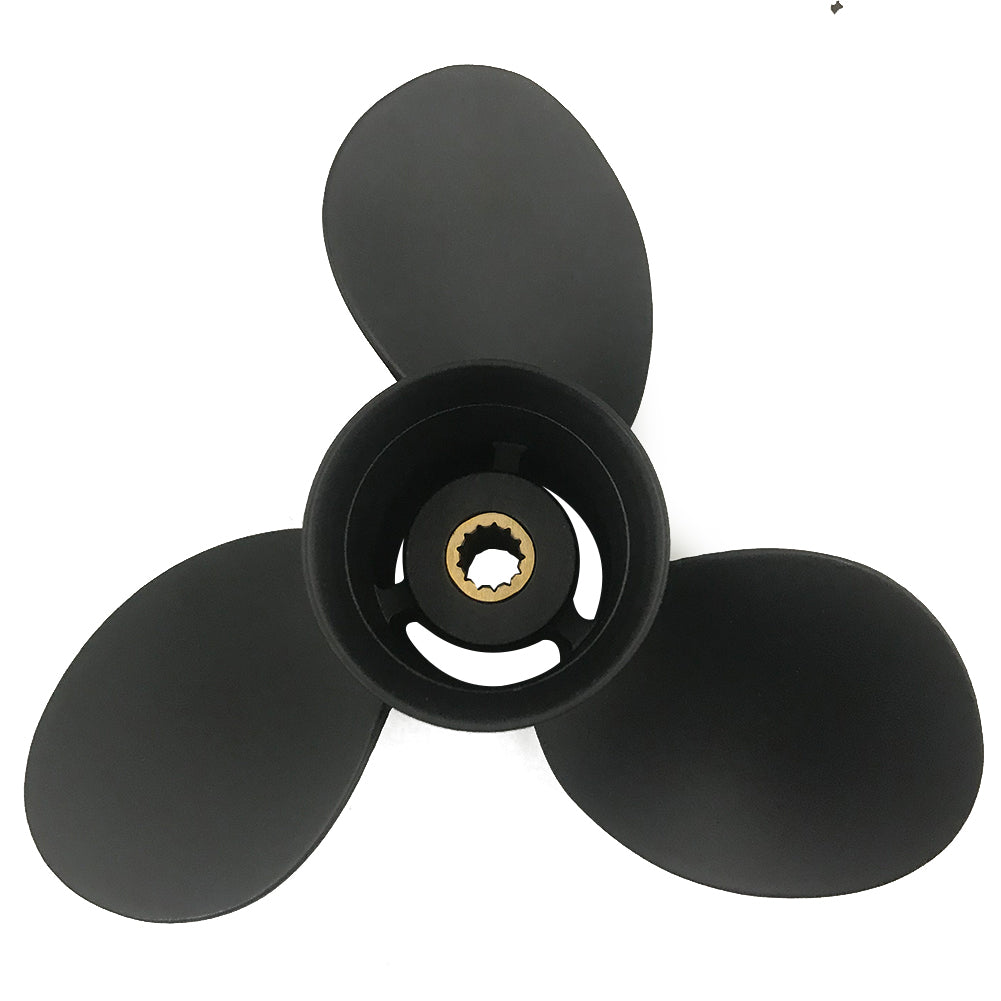How to Maintain and Optimize Your Inboard Boat Propeller for Long-Lasting Efficiency and Smooth Sailing
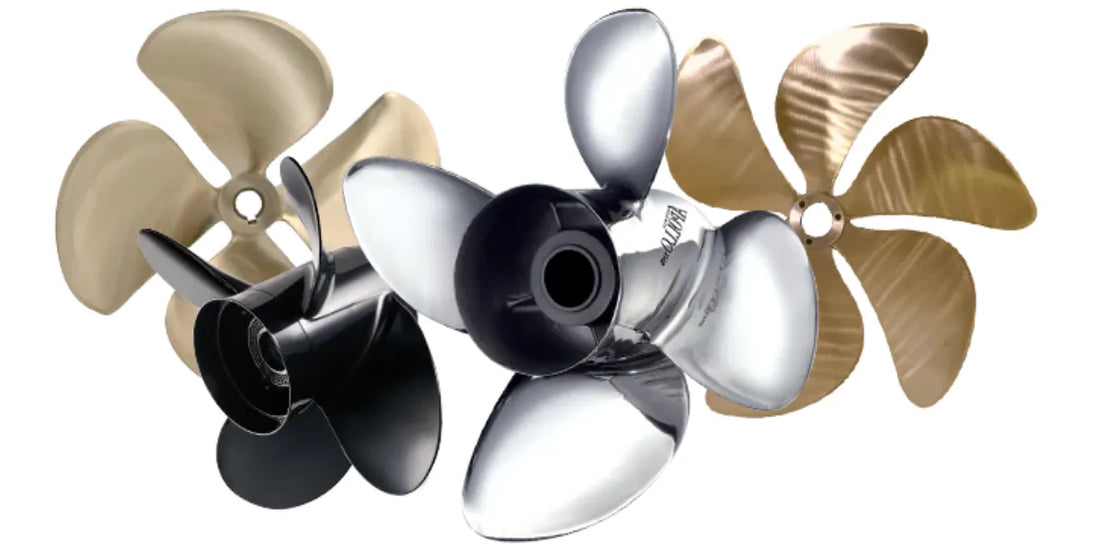
Proper maintenance and optimization of your inboard boat propeller are essential for a smooth trip on the water, good fuel economy, and the protection of your marine investment for a longer lifespan. Any seasoned sailor or amateur boat owner will know that understanding the basics of boat propeller care can go a long way in saving you tons of dollars, taking away the unwelcoming downtime, and shoddy on-the-water performance. This manual provides essential tips and techniques for maintaining your inboard boat propeller at its best, along with methods for maximizing power and enhancing overall boat performance. Through the inspection and assessment of faults in propeller efficiency, you will gain practical knowledge that will keep your journeys smooth and worry-free.
Understanding Inboard Boat Propellers

What is an Inboard Propeller?
An inboard propeller is a vital component of an inboard engine setup, typically found on boats used for water sports, fishing, or cruising. Unlike an outboard motor, where everything-the engine and the propeller-is mounted on the transom of the boat, an inboard configuration sees the engine positioned inside the hull of the ship. The underwater propeller is attached via a driveshaft that is steered by a rudder.
Constructed with a design that emphasizes efficiency and performance, inboard propellers are typically made of materials such as stainless steel or bronze, which are resistant enough to withstand immense pressure and corrosion. They are available in different configurations comprising two, three, and four blades, with each configuration made to enhance thrust, speed, and maneuverability based on the size and purpose of the actual boat. Choosing the right propeller for your needs and maintaining it will help you save fuel, ensure smoother operations, and increase the longevity of your boating equipment.
Types of Inboard Boat Propellers
Two-Blade Propellers: A two-blade propeller can be used on smaller boats, as well as on Vessels that require speed rather than torque. Considered extremely simple and lightweight, these types of propellers also reduce drag, allowing for higher RPMs, and are therefore perfect for racing or light applications. But with such a small area, this would limit the amount of thrust.
Three-Blade Propellers: The classic three-blade propeller is renowned for its balance between performance and efficiency. The thrust, torque, and fuel consumption it offers are suitable for almost every vessel type, ranging from recreational to fishing crafts. To some extent, the propellers reduce vibrations and noise, making smoother operations than their two-blade counterparts.
Four-Blade Propellers: Increasing stability and power for heavy-duty vessels, tugboats, or boats operating in rough waters, high-quality four-blade propellers can enhance low-speed maneuverability, increase grip in the water, and reduce cavitation during loading. Although it sacrifices a little speed, it is strong and capable of handling graded torque, making it a winner for the more demanding marine applications.
Custom and High-Performance Propellers: Considered the best custom propellers for unique boating needs, these are built to precise specifications. High-performance propellers are designed to generate thrust and conserve fuel, often leveraging the advantages of advanced materials and precision engineering to achieve a superior level of performance. These propellers become very common in competitive boating or in some specialized commercial operations.
Choosing the right propeller for an inboard boat, along with its size and power, varies depending on how the boat will be used. Depending on whether speed, stability, or fuel efficiency is a concern, each type of propeller is utilized for specific requirements, thus greatly contributing to the higher or lower performance and lifespan of a vessel.
Importance of Choosing the Right Inboard Boat Propeller
Selecting an appropriate inboard boat propeller is one of the key factors in achieving optimum performance, safety, and efficiency. An appropriately sized prop allows a vessel to attain its peak speed while doing so economically in terms of fuel consumption and engine maintenance. For instance, a watersports boat may require a propeller with a higher pitch to enhance acceleration. Still, a fishing vessel that desires more stability at lower speeds will need a different design.
It is believed that an incorrect propeller choice could reduce fuel efficiency by as much as 20%, according to several sources, depending on the boat's make and model, as well as its particular design. Moreover, improperly sized or mismatched propellers can strain the engine during operation, thereby reducing its service life. The advancements in material and design engineering have introduced options such as stainless steel propellers, which are among the most durable designs compared to traditional aluminum ones.
Getting the diameter, pitch, and blade configuration matched correctly allows the boater to ensure not only that the propeller is suitable for an engine's specifications but also that it meets its specific operational needs. Careful thought put into selecting a propeller pays off nicely in increasing the boating experience and lowering operational costs over time.
Factors Affecting Inboard Boat Propeller Performance

Diameter and Pitch Considerations
The diameter and pitch of an inboard boat propeller hold vital roles as far as its overall performance and efficiency are concerned. The diameter-that is, the circle created by the rotating blades-determines the amount of water displaced during movement. Larger diameters are required where greater thrust is employed for towage or heavily loaded operating conditions, whereas smaller diameters are used for high speed in lightweight configurations.
Conversely, the pitch is defined as the theoretical distance a propeller would move in one revolution through a solid medium if there were no slippage. Essentially, the larger the pitch, the greater the speed potential, but the more strain it places on the engine. Conversely, a smaller pitch means more pulling power, which can sometimes be preferable for water sports or slow cruising. When choosing pitch and diameter, it's highly recommended to consider the engine power, the weight of the boat, and the intended use. For example, a 20-inch diameter coupled with a 15-inch pitch would be ideal for heavy-duty tasks. In contrast, the smaller combination of 16 inches in diameter and 20 inches in pitch would be better suited for tasks requiring speed.
Working from the research axiom, a multitude of theories suggest that boaters weigh both the implications and requirements of propeller choice, thereby competing in terms of fuel efficiency, engine wear, and smooth boat experience. Any propeller design now is developed using modern engineering, which allows for fine-tuning to achieve great adaptability in meeting operational requirements.
Materials Used in Boat Props
The composition of an engine propeller determines its durability and performance; hence, the selection of propeller material depends on the reputation of aluminum and stainless steel. They will really have properties appropriate for various boat applications.
Being an affordable and lightweight option, aluminum gutter props are an excellent choice for casual and recreational use. They do not corrode in freshwater bodies. Provide reasonable service, but they are prone to damage in harsh situations or when possible impacts from underwater cause disturbance.
Stainless steel offers greater strength and durability, making it the preferred choice for high-horsepower engines and saltwater applications. The stiff nature of stainless steel enables relatively thin blade designs, which actually enhance performance and fuel efficiency by minimizing drag. Stainless steel resists impacts far better than aluminum and therefore lasts longer, albeit at a higher cost.
Composite materials have become a recent choice for engineers due to their lightweight properties and corrosion resistance. These props are generally used with modern boat designs that emphasize efficiency and ease of maintenance. Composite propellers are suitable for weaker applications, such as those with low to mid-power, as they are more forgiving; however, if damaged, replacement of a single blade is sometimes possible.
A continuous rotation of the material by manufacturers or coatings acts as a reduction of drag, resistance to marine growth, and improvement in life expectancy. When selecting the best material for boat propellers, a boater must consider factors such as working conditions, cost, and performance expectations to ensure a perfect match with their specific requirements.
How Design Affects Efficiency in Propeller Design
If the propeller design influences the performance and efficiency of the vessel, the blade strength or design is critical with respect to the forward motion of the ship. The shape, size, pitch, and rake of the blade design elements directly affect how a boat converts engine power into forward thrust; thus, some of these design parameters must work together for optimal performance. Using the right pitch system, a high-pitch propeller, which travels a high distance with every revolution, favors higher speeds. In contrast, low-pitched propellers increase the load on the engine in low-speed applications. Low-pitch propellers, instead, are higher-torque varieties and so suitable for towing or heavy loads.
The number of blades obviously will be another variable affecting performance. Three-blade propellers are commonly used due to their balance between speed and thrust, while four- and five-blade propellers allow smoother operation and greater grip, making them suitable for applications requiring more precise handling or stability. Further to that, the rake angle-the angle of the blade with the horizontal in relation to the hub-affects the lift characteristics of a propeller and, consequently, the staying on plane and the overall handling of the boat.
In recent times, with the advent of computational fluid dynamics (CFD) and solid design software, manufacturers can achieve a remarkably close-to-perfect design. This includes providing the blade with its exact curvature and thickness to prevent cavitation, a decrease in performance or efficiency, and eventual damage to the propeller. With vessels now equipped with the latest technical gadgetry, we can expect innovations such as variable pitch propellers that automatically adjust to varying operating conditions, thereby achieving maximum efficiency in a diverse range of operational modes.
By gaining an understanding of the intricate relationship between these design factors and boat operation, a boater can select a propeller tailored to the end use, which may be speed-oriented, fuel-efficient, or precise in handling.
Maintenance Tips for Inboard Boat Propellers

Regular Inspection and Cleaning
For optimal performance, regular inspection and cleaning of inboard propellers must be undertaken. Begin by inspecting the propeller for any physical damage; a ding, bend, or crack can compromise efficiency, leading to vibration or noise. Check that the propeller is firmly fastened and that the shaft is in good condition so as not to cause any misalignment.
Cleaning has to remove any marine growth, debris, or corrosion. Marine fouling could almost certainly hinder the propeller's function, hence affecting the speed and fuel efficiency. Use a soft brush or other non-abrasive tools to clean the surface, especially around the blades and hub, where matter accumulation is typical. Ensure that any protective coating is not damaged during this process. An anti-fouling paint applied regularly can help prevent further growth.
Keeping your propeller in good condition will ensure optimal bearing performance and, subsequently, a longer lifespan; costly repairs or replacements can be avoided in the future. Having a good maintenance schedule in place, for example, should entail inspections and cleanings before and after the season, so all adventures remain perfect with the condition of your propeller.
Damages or Signs of Wear Identification
Propeller damage or wear has several signs that should be detected to ensure optimal performance of the propeller. Possessing your propeller with cracks, small chips, or bends on the blade is one indication; these damages are acquired through collision with underwater debris or over time. Whenever there is obviously less speed or lift thrust under the state of regular RPMs in the engine, it may be a signal that your propeller has an issue of efficiency caused by damage or misalignment.
Uneven wear on the blades, such as corrosion spots or thinning edges, may be caused by poor care or unsuitable operating conditions, potentially compromising the propeller's efficiency. Excessive vibration and strange noises that occur during operation may, therefore, strengthen the case for imbalances or structural weaknesses. To rectify these situations, regular checks should also include inspections for loose-fitting components, such as hub and shaft connections, which can wear and degrade performance if loose.
Being aware of these warning signs enables timely repair or replacement, which will actually save money before requiring further, more costly repairs, while allowing for a safe and smooth boating outing.
When to Replace Your Inboard Boat Propeller
At the core of the system stands the mechanism for maintaining your boat's efficiency and performance. With the passage of time, wear and damage will decrease their effectiveness, and it is essential to recognize when the replacement will give you the best boating experience. These are clear indicators that will help you decide if you really need to replace your propeller:
Decreased Performance and Efficiency: A sudden drop in speed, limp acceleration, and increased fuel consumption typically indicate issues with the propeller. These symptoms suggest that the propeller is either worn, bent, or damaged, which prevents it from transferring power efficiently.
Visible Physical Damage: Inspect for visible signs of wear and tear on your propeller, such as cracks in the blades, dents, or scraping off of the blade material. Such damage, however minor, has the power to cause imbalance, which hinders performance and reduces the lifespan of your drivetrain components.
Unusual Vibrations: Excessive vibration while operating the boat is usually attributed to damage or misalignment of the propeller. Such vibrations compromise the comfort of the operation and, if left unchecked, can escalate into more significant mechanical issues.
Corrosion on Propeller Blades: For vessels used in saltwater environments, corrosion can erode the propeller material over time. A corroded propeller loses its durability and efficiency, and therefore demands replacement before it fails.
Failing to Achieve Desired RPMs: When a boat engine struggles to remain within its recommended RPM range, it potentially suggests that the propeller has lost its optimum pitch or size. This problem can be caused by general wear or the improper use of equipment that is not sized correctly.
Regular Repairs and Adjustments: If a propeller is constantly serviced, it may indicate that it is losing its operational capabilities, reaching the end of its life. Thus, converting to a brand-new, high-quality one would save time and money by providing constant performance.
Engine Power Increase: If you've been tempted to upgrade your motor in the hope of securing more horsepower, you must ensure your propeller is rated for this change in top-end power output. An old propeller may fail to accommodate such changes, resulting in impaired performance.
Checking such signs actively makes it easier to detect when you should consider replacing your unit, thus keeping the boat in its best working state. Proper maintenance and selecting the correct replacement prop will surely enhance your craft's performance, reduce fuel costs due to efficiency, and guarantee you will have fun while boating.
Optimizing Your Inboard Propeller for Better Performance

Mods to the Pitch and Diameter
An ideal choice of pitch and diameter for the inboard propeller greatly depends on achieving maximum performance. The pitch is the theoretical distance covered by the propeller in one rotation while moving forward. In contrast, the diameter is the diameter of the circle traced by the tips of the propeller blades. Together, these factors increase a boat's speed and thrust, as well as enhance fuel efficiency. For example, a smaller pitch would cause the ship to accelerate more effectively and pull harder, making it better suited for boats carrying heavier loads. On the other side, a higher pitch may be desirable for lighter vessels aiming for higher top speeds.
In any situation where the diameter is changed, the engine's power and the boat's design must be taken into account. Larger in diameter generally means more thrust and is therefore suitable for towing or heavy-duty applications; however, improper matching can place excessive strain on the engine. On the contrary, a smaller diameter reduces drag, allowing the boat to attain a greater speed. By focusing on balancing the pitch and diameter, the overall performance of the inboard propeller will be improved, resulting in smooth handling, enhanced fuel economy, and ultimately, a more enjoyable experience while operating a boat. Continuing to operate through a marine professional or even a propeller calculator capable of advanced calculations will help you shore up the last few adjustments to suit your particular boating profile.
The Advantages of Upgrading to High-Performance Propellers
High-performance Acme and Michigan Wheel propellers can significantly enhance a pleasure craft's performance in speed and efficiency. They hold a reputation of engineering perfection that assures their Ingersoll and utmost working performances under different types of water conditions. From Acme, propeller products are manufactured using proprietary CNC machining technology, which provides precise blade designs that minimize vibration and maximize thrust. Similarly, Michigan Wheel offers a wide array of models that increase fuel efficiency, acceleration, and handling.
In response to the data, one finds that more advanced propellers tend to equally improve planing speeds, minimize fuel consumption, and better align rpm. Acme, for instance, was able to create blade geometries that reduced cavitation and provided a smoother ride even at relatively high speeds. On the other hand, Michigan Wheel uses the latest materials such as nibral alloys, which maintain top performance while resisting corrosion in both inland (freshwater) and saltwater conditions. Time and time again, careful selection of propellers should be ensured by what you intend to do with your boat, including its top speed, pulling power, and efficiency for water sports, or fuel efficiency for the long haul. In conjunction with periodic performance evaluations, having a control group of marine specialists will ensure that the upgrade brings about quantifiable improvements tailored to your vessel.
Adjusting Propeller Position for Improved Handling
This is about the placement of your boat's propeller, a crucial factor that ensures smooth handling and performance. Any position maintained for a propeller forearm should provide the proper amount of thrust, reduce cavitation, and maintain stability while operating. For example, if the prop is a bit higher, it lessens drag, which means it travels a bit faster and saves fuel; if set low, there is better grip on rough waters, resulting in smoother handling.
Before making adjustments, consider the hull type, engine, and intended use of your vessel. Try testing various positions in small increments; this will help you determine which configuration works best under your specific conditions. Performance testing data reveal that prop height adjustment may come into play when it is not possible to clearly distinguish between speed and control, particularly under variable water conditions. Additionally, input from fellow marine technicians and utilizing tool applications, such as jack plates, will greatly ease the processes and facilitate the most accurate adjustments. With continued evaluation and readjustment, the handling will improve, ultimately surpassing the decline in engine and propeller life.
The Market for Inboard Boat Propellers

Inboard Boat Propellers for Sale: Where to Look
When searching for inboard boat propellers for sale, I recommend starting with an established marine supply store, either locally or online. Such sellers typically stock a wide range of propellers for various boat sizes, engine types, and performance requirements. Some of these suppliers may even offer consultations to help you decide on the best propeller for your application, considering factors such as horsepower, marine environment, and usage patterns. Websites focusing on marine e-commerce or manufacturer sites offer great opportunities by including the usual features, such as spec sheets, user reviews, and wholesale prices.
Another great option is to explore secondhand markets if you want to save money. Reputable websites and forums devoted to boating enthusiasts often have listings for used or refurbished inboard boat propellers. I have found it especially useful for both the more affordable choices and the highly specialized models. That said, I always ensure that the item is in good condition, compatible with my boat, and that the seller's credibility is verified whenever I am considering a purchase.
Lastly, another method of securing high-quality inboard propellers is to contact manufacturers or authorized dealers directly. The manufacturer should be your best bet when purchasing a new propeller, allowing you to access newer models, warranties, and sometimes discounts or promotions. Some dealers will also offer a trade-in deal, allowing you to upgrade your propeller at a discounted price. By approaching it this way, you end up with the perfect propeller for your specific needs and budget.
Comparing Prices and Options
My first approach when comparing prices and options for inboards is thorough research across multiple sources. I check online retailers, boating forums, and specialty merchants for an idea on current market prices and product availability. By pitting his offers against one another, he can spot trends and narrow down to models that fit under his budget and meet his performance needs. He also takes note of discounts, thinking they might help him save some money without compromising quality.
Going further, I now place more emphasis on the appraisal of value rather than giving full weight to the price. Thus, material syntax, durability, warranty period, and reviews are among the variables to consider. One must consider how these factors could positively or negatively affect the life and serviceability of the propeller. Cheap options often fail, and I've learned that investing in a quality product is usually the best strategy for saving on repairs or replacements in the future. Furthermore, whenever a more customized solution might better meet an inordinate need of mine, I shall pursue it and see if it can be done, as manufacturers and dealers can sometimes offer it at quite reasonable prices.
On the other hand, I would consult a trustworthy expert, or I could even ask other boaters I know for their recommendations and insights into pricing. You see, somebody else's firsthand experience might have either validated a choice or brought to your attention some hidden costs that never crossed your mind before. Compared to just price comparison, now that I have gained some expertise, I can make a more confident choice about going for the best price for what I need. Affordability with the level of quality will always be my motto.
New Innovations in Marine Propeller Technology
One of the most interesting developments in marine propeller technology is the modular propeller. The blades are interchangeable, allowing for simpler and less expensive maintenance or performance adjustments to suit different conditions. For instance, if I want one speed or load in one set of waters, I can arrange my speed or load differently in another set of waters. Such adjustments are introduced through the blade arrangement without requiring the replacement of the entire product. This adaptability is, of course, a cost-saving measure, as well as saving time, as the boat does not have to be off the water for extended intervals.
An improvement is the advent of advanced materials such as carbon fiber composites and titanium alloys. They offer enhanced durability and corrosion resistance, especially in saltwater conditions. For me, this means less wear and tear over time and more assurance that my propeller is built to withstand even the most demanding conditions. Additionally, the lighter weight helps reduce fuel consumption, resulting in higher fuel savings and a smaller environmental footprint.
Ultimately, advancements in hydrodynamic design and computational modeling enable manufacturers to produce propellers with maximum thrust and minimal cavitation. These state-of-the-art designs translate into quieter, smoother, and more fuel-efficient operations. I find it fascinating how technology comes to the aid of efficiency and sustainability, enabling me to make my boat perform better and contribute to a broader and more sustainable green boating agenda.
Reference Sources
-
Propeller Maintenance - Mercury Marine: Offers tips on inspecting propeller blades, removing burrs, and maintaining propeller efficiency.
-
A Must-Know Guide to Boat Propeller Maintenance - Deep Blue Yacht Supply: Covers visual inspections, cleaning, greasing the prop shaft, and protecting against corrosion.
-
Inboard Boat Maintenance – a Complete Guide - GetMyBoat: Includes advice on lubricating the propeller shaft and using high-quality marine grease for smooth operation.
-
A Must-Know Guide to Boat Propeller Maintenance - Deep Blue Yacht Supply: Another detailed guide from the same source, emphasizing corrosion protection and regular inspections.
Frequently Asked Questions (FAQs)
What are some benefits of an inboard prop for a boat?
An inboard propeller enjoys quite a few benefits, including better control and maneuverability. These propellers are usually placed within the hull for added protection against underwater obstacles. The inboard propellers are renowned for their superior performance, commonly used in both recreational and commercial applications, and offer robustness and power. Secondly, an inboard propeller tends to offer slightly better fuel efficiency, adding to its popularity among boat owners. Considering that there are different models in the market, you can choose the inboard prop that best suits your boat size and engine power.
How does one select an appropriate inboard prop for their boat?
The diameter, pitch, and blade count are the deciding factors in choosing the right inboard propeller. The diameter determines thrust and speed, while the pitch suggests how much the boat will move in one rotation. Those who want to maximize performance should ensure the prop fits the engine and the intended use of the craft, whether for pleasure or wakeboarding. Boat builders mostly suggest using 3-blade and 4-blade props, depending on whether you would like to be faster or able to carry a heavy load. Additionally, seek out numerous opinions from seasoned boat owners or professionals who are most familiar with your particular model.
What is the difference between stainless steel and bronze inboard boat propellers?
Nature of docks, piers, and anchoring in varied bodies of water suggests the inherent characteristics of types of stainless steel and bronze inboard boat propellers that affect their performance. Considering the high performance and life of stainless steel propellers, they are made for high-speed boats. They are usually more fuel-efficient and have less vibration. On the contrary, a bronze propeller tends to be less expensive and offers acceptable performance under all conditions. One may consider them more forgiving in terms of durability to minor hits. Choice basically rests on the nature of your boat application and your own interests.
What about finding sales for inboard propellers?
A big inventory of different inboard propellers can be found in marine supply stores, as well as at different online retailers and specialized websites selling boat parts. Most dealers offer superior choices, for example, Nibral or aluminum propellers. Moreover, vendors with a large selection of inboard boat propellers sometimes make an appearance at your nearest boat shows and expos. Prices and specifications should be compared to ensure the best possible propeller for your vessel. You should also check the shipping options when buying online.
What significance does propeller pitch hold in the case of inboard boat props?
The pitch is one of the key parameters that determines the performance of your boat in the water. It is the theoretical forward movement of the propeller in one complete revolution. More pitch implies more speed but less acceleration, while less pitch provides better thrust and acceleration, which is helpful for heavier loads or wakeboarding activities. Know the requirements of your boat and the power of your engine to help in deciding the proper pitch of your inboard props. The diameter-pitch balance is a key factor in performance and fuel economy.
How does blade area affect the performance of inboard boat propellers?
The blade area of inboard boat propellers strongly influences thrust generation and, therefore, performance. A propeller with a larger area generates more thrust. This feature is necessary for heavy vessels or applications requiring strong acceleration, but it adversely affects the top speed. A smaller blade area, on the other hand, yields more speed but less thrust. Consider the requirements of your boat and engine when selecting a propeller with a location that meets those requirements.
